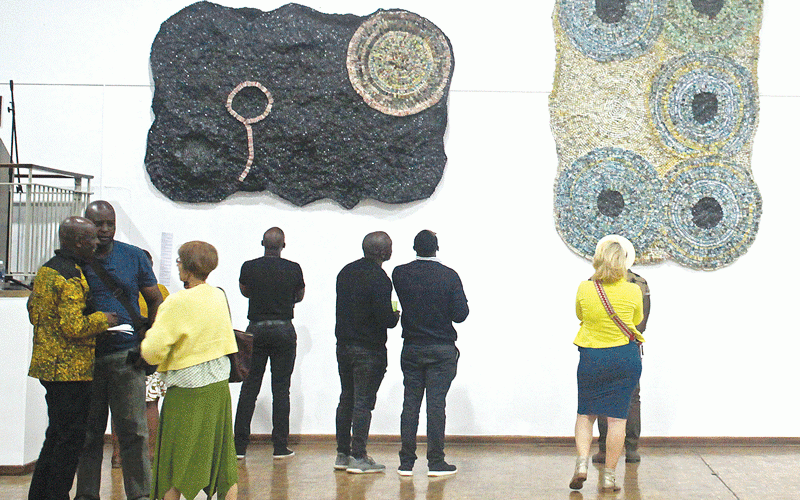
THE hype from having his work in the Los Angeles headquarters of Roc Nation, owned by hip-hop mogul Jay Z, does not define local visual artist Moffat Takadiwa’s success.
The artist’s ideological commitment precedes his newly minted celebrity status. His career was born out of consistently challenging Africa’s post-colonial narrative.
At the National Gallery of Zimbabwe (NGZ), Takadiwa’s first major solo exhibition in the country is a resounding call for diligence against the remnants of colonial power.
Curated by Fadzai Muchemwa, NGZ’s contemporary art curator, Takadiwa’s exhibition runs under the polemic title Vestiges of Colonialism.
The show is made up of repurposed materials that range from refills of ballpoint pens to used toothbrushes, and computer keyboards keys.
The elements are weaved together into intricate designs and eye-catching patterns with attractive colour schemes.

Most Zimbabweans are used to seeing the artist’s raw materials as an eyesore piling up at undesignated dumping sites, where they are mixed with stinking biodegradable garbage.
- Daily life struggles reflected in Burning Figure
- Baker’s art work inspired by personal experiences
- NGZ to honour winning finalists
- Stage set for visual arts awards ceremony
Keep Reading
To then see the discarded waste materials elevated to high art is a mind-bending experience.
Understanding Takadiwa’s practice requires analysing his raw materials, how they were acquired and where they fit into his narrative.
The restoration of value to the materials can be seen as a blueprint for succession to stability from victimhood.
Most of Takadiwa’s materials are components from goods that were imported from Western countries.
The goods are either dumped in the country because they have become obsolete in their country of origin, or because the receiving country has no capacity to manufacture its own products.
The artist uses both scenarios to illuminate the hierarchies of power between Western countries and their former colonies.
His use of plastic materials also raises awareness about the environmental hazard posed by non-biodegradable waste originating from developed countries.
Walking into the exhibition, the audience is welcomed by a carpet of used toothbrushes in various colours arranged to a form of the Star of David.
The six-pointed star with intersecting lines is a surprise welcome for most of the audience, and quick recognition sets the mood for sombre reflections.
The installation, however, is titled Walk of Shame, and is an inversion of the famous Hollywood’s Walk of Fame.
Promising transcendence, the first artwork on the wall is titled Fixable Mistake. It is a beautiful tapestry in black, white and green colours. It carries a reassuring message in the age of the cancel culture.
The piece is an ideal place to circle back to before leaving the show as it is mounted at the entrance, which is also the exit from the exhibition.
A crowd favourite and background to hundreds of pictures and selfies is Bhiro ne Bepa (pen and paper), which does not need to be decoded to be appreciated.
With this piece, the artist charms his way into people’s hearts. Made from pen refills, toothbrushes, and computer keys, its overwhelming beauty still carries a serious message about the power that comes from documents and those behind the pen.
The grandeur of pre-colonial Africa is invoked through a multiple part series titled Korekore Handwriting.
The panels carry symbols that can be associated with African writing systems from graphic designer and typographer Saki Mafundikwa’s seminal work in his book Afrikan Alphabets: The Story of Writing in Afrika.
Rugare Kwamuri is a tongue in cheek statement that could mean a lot of things. Literally, it means “peace be unto you”. It is familiar to the public as a chant mostly used by Zimbabwe’s apostolic sects at their gatherings.
The phrase is applied as a title to an installation of vegetables planted in drawers that the artist refers to as “administration furniture”.
A hint of discrimination is encoded in the term administration because in Zimbabwe during colonial rule, the law barred black people from holding public office. Rugare is also the name of the type of vegetable used by the artist, which is grown in high-density suburbs as a common diet for poor people.
A series of wall hangings have been titled Colonial Product.
Takadiwa’s mesmerising “products” induce introspection through intricate designs and varied materials in the composition of the artwork.

From the title, one gets the sense that the artwork references more than material substance.
Another installation is a vast library of vinyl record sleeves. The artists featured on the records represent Western culture and European taste.
Possibly hauled from an auction, the music library invokes the essence of a privileged other.
Curiously titled Mudiwa’s Kitchen, it can be read as a provocation that insinuates unhealthy assimilation of white culture.
Seen from below as well as the upper levels of the gallery are three funnel-shaped and two cylindrical giant white sculptures suspended in the air like objects travelling through space.
The work titled Mushonga Wezino is made from toothpaste tubes. The Shona title means medicine for the tooth, suggesting preventative measures to avoid decay.
The cavernous structure of the objects might suggest cavities (mhango), an illusion that is buttressed by the tiny holes on the toothpaste tubes.
Same Old Song is made from an entangled mess of spool from analogue tapes flowing from the ceiling and anchored by vinyl records on the floor. The installation might, however, look weird to the younger generation that never used the technology.
For the older generation, it may bring nostalgia and attachment to a romanticised past. The title has a ring to it that recalls the famous acronym SAMO, a graffiti tag associated with African-American artist Jean-Michel Basquiat.
The vestiges of colonialism can be insidious in a way that even Takadiwa cannot help himself sometimes.
The installation Maruva Enyika is a re-appropriation of colonial administration furniture, which the artist turns into a garden by having tiny bottle containers carrying stems from a rose bush plugged in a scorched table top.
There is dissonance in the application of a popular Shona phrase maruva enyika, which is commonly used as part of a proverb that warns against the lust for beauty.
Indigenous languages have been an integral part to Takadiwa’s discourse through titles to some of his work and often the exhibition itself.
Here, a meaning that is more entrenched in local traditions is dismissed and supplanted by the image of roses (a plant native to northern temperate regions), which does not fit well into an allegory about native life in Zimbabwe.
Born three years after independence, Takadiwa grapples with issues and systems that came into play before his time. Sometimes the struggle becomes violent as in the piece Sando Dzako (big up), where he turns a piece of furniture associated with the colonial past into charred remains riddled with nails.
The colonial artifact, which formally served as a table, undergoes deconstruction into a symbol of the artist’s trauma. There is a lot to unpack in Takadiwa’s work, and much of it unsettles those who label his generation as the “born free”.







